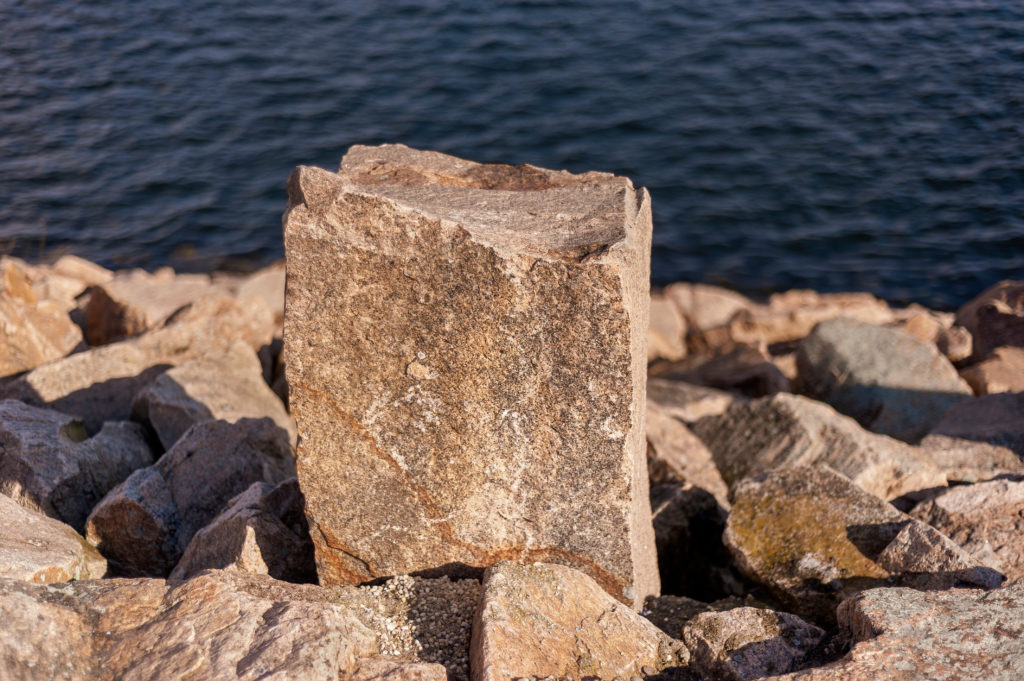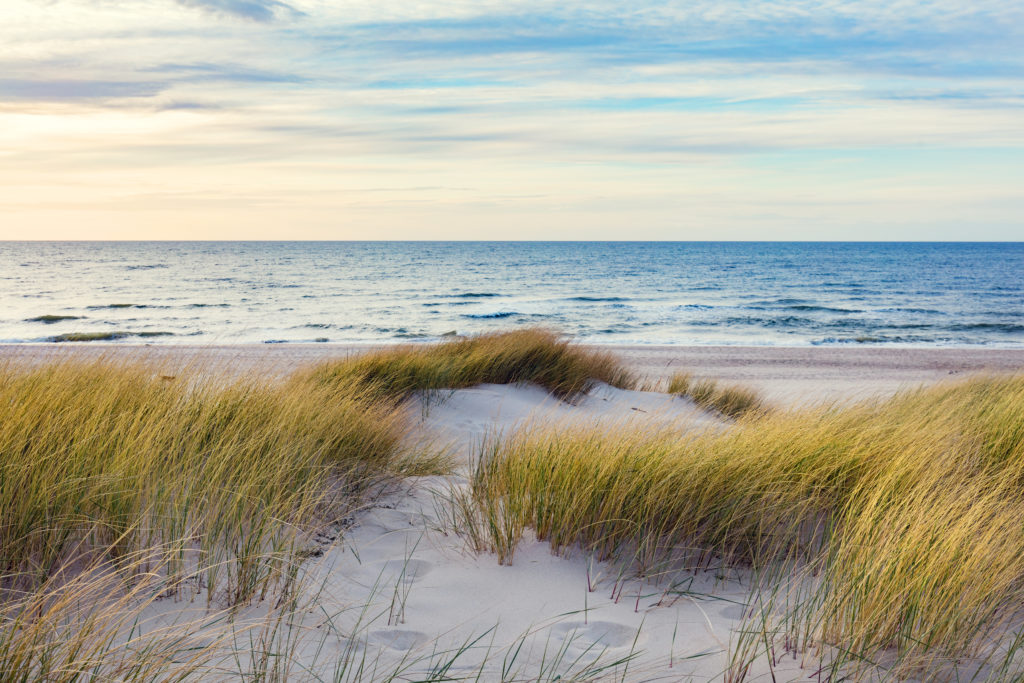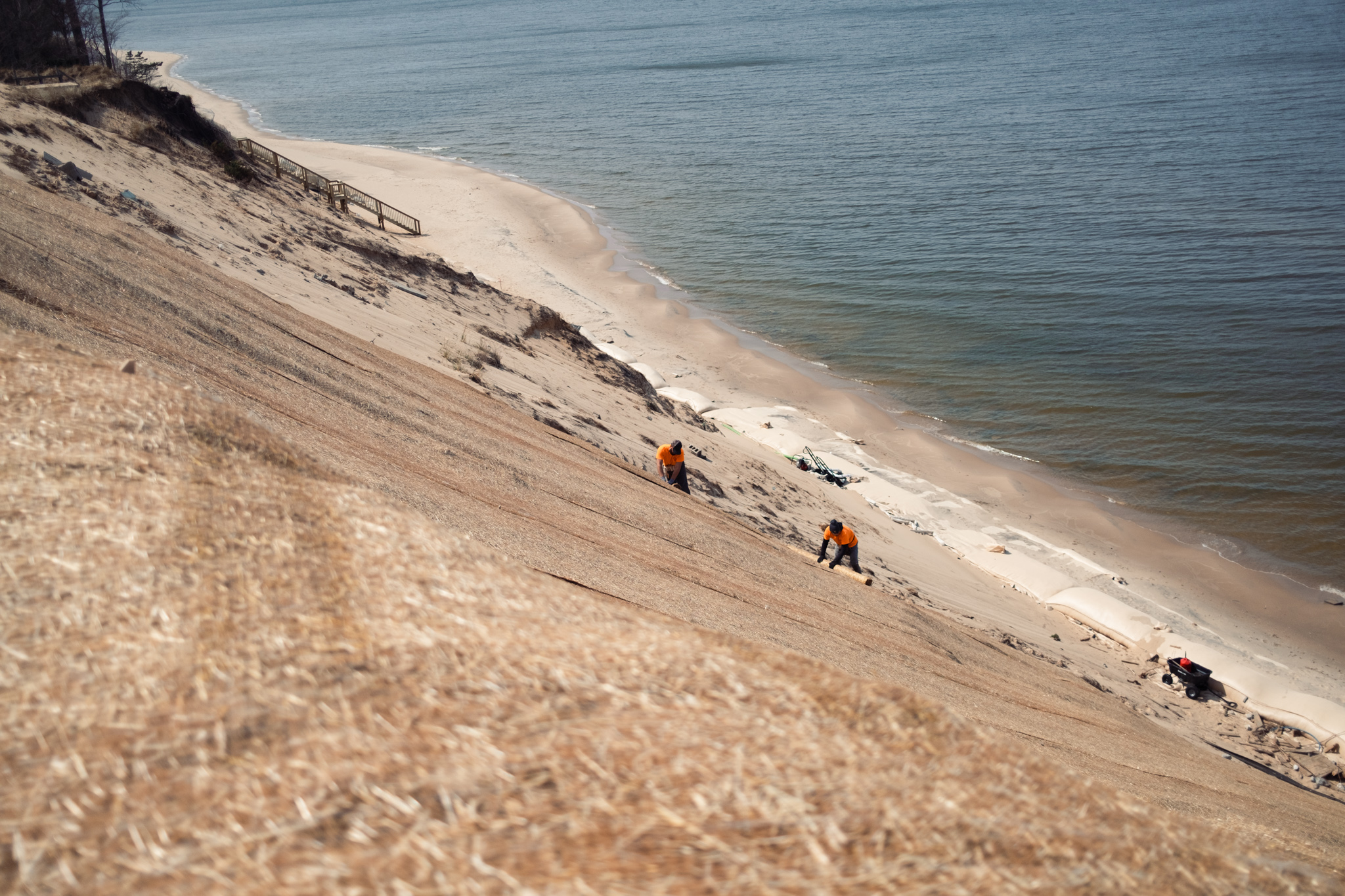If you’re a homeowner on Lake Michigan, you’re no stranger to the erosive effects of the lake along the shoreline. Erosion is a constant process and no method can offer a completely permanent solution, but by choosing the right method of shoreline erosion control, you can mitigate its effects. In this blog post, we cover five methods of lake shoreline erosion control, how they work, and when to use them.
Vegetation
Vegetation is a very important part of controlling erosion along the shoreline and stabilizing beaches. Planting vegetation is not only an easy, natural erosion control method, but can be used in combination with other erosion control methods for more effective erosion management.
How it works
Shorelines, beaches, lakeshore properties, and dunes are especially susceptible to erosion from the wind, changing water levels, storms, and waves (in addition to erosion from water runoff). Planting or re-establishing lost vegetation can prevent erosion in these five ways:
- Plant roots hold soil in place, stabilizing the area in which vegetation is planted.
- Vegetation absorbs the water that would otherwise hit the area hard in the form of water runoff.
- Vegetation decreases the harsh erosional effects of wave runup.
- Vegetation acts as a barrier to collect windblown sand and prevents the area from sand loss.
- Vegetation can keep foot traffic in the erosion-damaged areas to a minimum.
It is important to note that not just any vegetation will do—the species of vegetation must be sturdy enough to withstand erosional forces and harsh conditions and be effective.
When to use:
You should use vegetation for erosion control when the shoreline area in question has no roots or foliage to hold its sand and mounds from moving. Vegetation is appropriate for virtually any shoreline application where the sand is exposed to wind and waves, including dunes and beaches. We apply vegetation using a hydroseeding method to spray the seed onto the affected area. We plant fast-growing grasses that rapidly start the process of erosion prevention.
Stabilize Your Property with Vegetation Today.

Geotextile Tubes / Sandbags
Geotextile tubes or sandbags are a relatively cost-effective, customizable, and quick method for coastal protection in severe conditions. They hold up well during storms, are durably built for constant exposure to the elements, and have a natural appearance. The tubes are made from a sturdy, sand-colored, woven geotextile material. They are then pumped with a mixture of upland sand and water. With the technology from the fabric of the bags, the water then drains out leaving the sand inside the bag.
How it works
Sandbags or geotextile tubes stop erosion by:
- Stabilizing the existing sand or soil on which they are placed to prevent further erosion damage.
- Reducing the erosional impact of waves on the area by absorbing their impact.
- Geotextile tubes can be stacked to form “walls” and are used in both permanent and temporary applications to protect lakeshore properties and beaches from erosive waves.
At Lakeshore Customs, we’ve witnessed the erosive effects on Lake Michigan’s dunes and bluffs. We install geotextile tubes as a fast-acting temporary solution to protect them. Protecting the toe of dunes with geotextile tubes secures the whole bluff itself and restores the dunes to their natural angle of reposition. Not only do geotextile tubes prevent erosive damage, but also prevent property damage for our local lakeshore property owners.
Let’s Connect to Protect Your Land.
When to use:
Geotextile tubes are a smart erosion control method along shorelines and dunes where homes and property are threatened. Geotextile tubes are a great line of defense where there are strong waves crashing into the shoreline and you need a quick temporary solution.
Take Action and Protect Your Shore with Geotextile Tubes.
Erosion Control Blankets / Straw Mats
Erosion control blankets (or straw blankets, straw mats) are another method to protect dunes that have no existing vegetation or foliage. Erosion control blankets are straw mats that are rolled from the top of the dune down to the bottom and staked into the sand/soil with wooden stakes. There are many different types of blankets; some are temporary and some can be permanent until removal is desired.
How it works
Erosion control blankets help prevent shoreline erosion by slowing the flow of water across the area and stabilizing the soil. This is achieved by the netting or material that they are made of—the ridges and obstructions slow water, prevent soil shift, and promote new vegetation growth. Once straw erosion control blankets are laid on the dune and the sand is prevented from moving around, plugs or seeds are planted into the blankets.
Learn more about how erosion control blankets work.
When to use:
The natural conditions of the area you are trying to stabilize will affect your use of erosion control blankets or straw mats. Five things to consider when using blankets for shoreline erosion control are:
- Soil conditions
- Steepness of dune slope
- Length of dune slope
- Duration of protection needed
- Time to establish vegetation
At Lakeshore Customs, we are experienced in Erosion Control Blanket/Straw Mat installation and vegetation re-establishment along the West Michigan lakeshore.
Take action today to restore your dunes with an Erosion Control Blanket.
Seawalls
Seawalls are vertical concrete wall structures placed parallel to the shoreline designed to prevent upland erosion and protect from waves crashing against the shore. Backfill can then be applied behind the revetment to stabilize it and provide extra material for dunes to return to their natural angle of reposition.
How it works
Seawalls work by preventing strong, erosive waves from coming into contact with the beach or dunes on the other side of the seawall. Reflecting the extremely powerful wave energy back into the lake can greatly reduce the harmful effects of erosion. However, seawalls may have the disadvantage of contributing to “flanking erosion,” or increased erosion on the areas adjacent to the seawall that have no protection.
How effective are seawalls? Seawalls are effective where they are absolutely necessary for protecting shoreline infrastructure from flooding and erosion. However, sometimes they simultaneously have the detrimental effect of causing flanking erosion farther down the coastline. For this reason, seawalls are a point of contention when it comes to shoreline erosion control.
When to use:
Seawalls are used to prevent eroding cliffs and to protect land, lakeshore properties, and infrastructure from coastal flooding. Backfilling should be done in conjunction with seawall installation to stabilize the structure, prevent erosion from occurring behind the structure, and improve its functionality.

Riprap
Riprap is rocky material that can be placed along the shoreline to protect from wave erosion and scour. The size of riprap rock ranges from a few inches to over 2 feet! The size of your riprap will depend on the size of the project, the steepness of the slope, etc.
How it works
Riprap rock works by absorbing the flow and energy of waves that would otherwise be erosive to the shoreline. It is installed in a wall formation to protect long stretches of shoreline and riverbanks.
Riprap has the advantage of dissipating erosive wave energy, looking natural, and being relatively cheap to install and easy to maintain. However, it has its disadvantages because it does not work for every location and application, is not permanent, and does not protect from flooding that comes through from adjacent properties that have no protection.
When to use:
Riprap may be used along any shoreline or riverbank that is continuously exposed to erosive waves or rushing water.
Lakeshore Customs Restores, Enhances, and Protects Your Property.
Proudly serving Michigan’s land and lakeshore community, our goal is to prevent natural erosion and weather-related circumstances from harming your land. If your shoreline property suffers from erosion, ask us about our lakeshore services today.
Related Resource
Dune Restoration: Protecting your Lake Michigan Beach
Removing Your Geotextile Tubes from Your Beach


